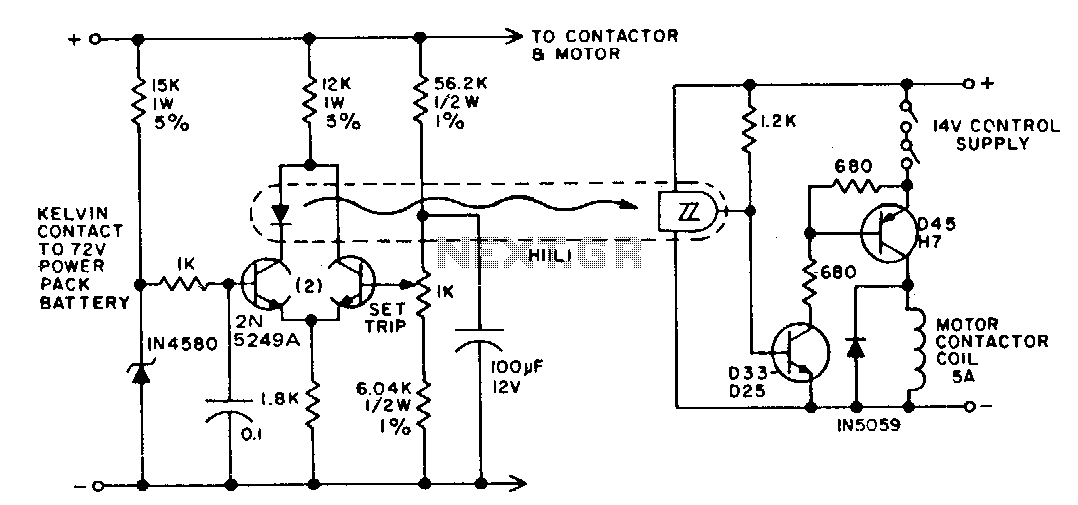
Electric-vehicle-battery-saver

The battery life and operating cost of an electric vehicle are significantly impacted by the overdischarge of the battery. This circuit is designed to provide both a warning and a shutdown mechanism. An electronic switch is connected in series with the propulsion motor contactor coil, allowing for three modes of operation. When the propulsion power pack voltage exceeds the 63-V trip point, the electronic switch does not affect operation. If the propulsion power pack's no-load voltage falls below 63 V, power will not be supplied to the propulsion motor, as the electronic switch will prevent the contactor from operating. Additionally, when the propulsion power pack's loaded voltage drops below 63 V, the contactor will open and close due to the electronic switch's action. This bucking operation alerts the operator to the need to recharge the batteries.
The described circuit plays a crucial role in managing the battery health and performance of electric vehicles by preventing overdischarge, which can lead to reduced battery life and increased operating costs. The electronic switch acts as a safeguard, ensuring that the propulsion motor only operates within safe voltage limits.
The circuit is designed with three operational states based on the voltage levels of the propulsion power pack. In the first state, when the voltage is above 63 V, the electronic switch remains closed, allowing normal operation of the propulsion motor. This state is ideal for driving conditions where the battery is adequately charged, and the vehicle can function without restrictions.
In the second state, when the no-load voltage of the propulsion power pack drops below 63 V, the electronic switch opens, preventing the contactor from closing. This action effectively disconnects the propulsion motor from the power supply, thus protecting the battery from further discharge. The operator is notified of this condition, which serves as a prompt to recharge the battery.
In the third state, when the loaded voltage drops below 63 V, the electronic switch’s operation again comes into play. The contactor will open and close in response to voltage fluctuations, indicating that the vehicle is nearing its operating limits. This bucking behavior serves as an additional warning mechanism to the operator, signaling the urgent need to recharge the batteries to avoid potential damage from overdischarge.
Overall, this circuit design is essential for maintaining the longevity and efficiency of electric vehicle batteries, ensuring that they operate within safe parameters while providing timely warnings to the operator.The battery life and operating cost of an electric vehicle is severely affected by overdischarge of the battery. This circuit provides both warning and shutdown. An electronic switch is placed in series with the propulsion motor contactor coil. Three modes of operation are possible: When the propulsion power pack voltage is above the 63-V trip point, the electronic switch has no effect on operation.
When the propulsion power pack no load voltage is below 63 V, power will not be supplied to the propulsion motor since the electronic switch will prevent contactor operation. When the propulsion power pack loaded voltage drops below 63 V, the contactor will close and npen because of the electronic switch.
The bucking operation indicates to the operator need to charge the batteries.
The described circuit plays a crucial role in managing the battery health and performance of electric vehicles by preventing overdischarge, which can lead to reduced battery life and increased operating costs. The electronic switch acts as a safeguard, ensuring that the propulsion motor only operates within safe voltage limits.
The circuit is designed with three operational states based on the voltage levels of the propulsion power pack. In the first state, when the voltage is above 63 V, the electronic switch remains closed, allowing normal operation of the propulsion motor. This state is ideal for driving conditions where the battery is adequately charged, and the vehicle can function without restrictions.
In the second state, when the no-load voltage of the propulsion power pack drops below 63 V, the electronic switch opens, preventing the contactor from closing. This action effectively disconnects the propulsion motor from the power supply, thus protecting the battery from further discharge. The operator is notified of this condition, which serves as a prompt to recharge the battery.
In the third state, when the loaded voltage drops below 63 V, the electronic switch’s operation again comes into play. The contactor will open and close in response to voltage fluctuations, indicating that the vehicle is nearing its operating limits. This bucking behavior serves as an additional warning mechanism to the operator, signaling the urgent need to recharge the batteries to avoid potential damage from overdischarge.
Overall, this circuit design is essential for maintaining the longevity and efficiency of electric vehicle batteries, ensuring that they operate within safe parameters while providing timely warnings to the operator.The battery life and operating cost of an electric vehicle is severely affected by overdischarge of the battery. This circuit provides both warning and shutdown. An electronic switch is placed in series with the propulsion motor contactor coil. Three modes of operation are possible: When the propulsion power pack voltage is above the 63-V trip point, the electronic switch has no effect on operation.
When the propulsion power pack no load voltage is below 63 V, power will not be supplied to the propulsion motor since the electronic switch will prevent contactor operation. When the propulsion power pack loaded voltage drops below 63 V, the contactor will close and npen because of the electronic switch.
The bucking operation indicates to the operator need to charge the batteries.